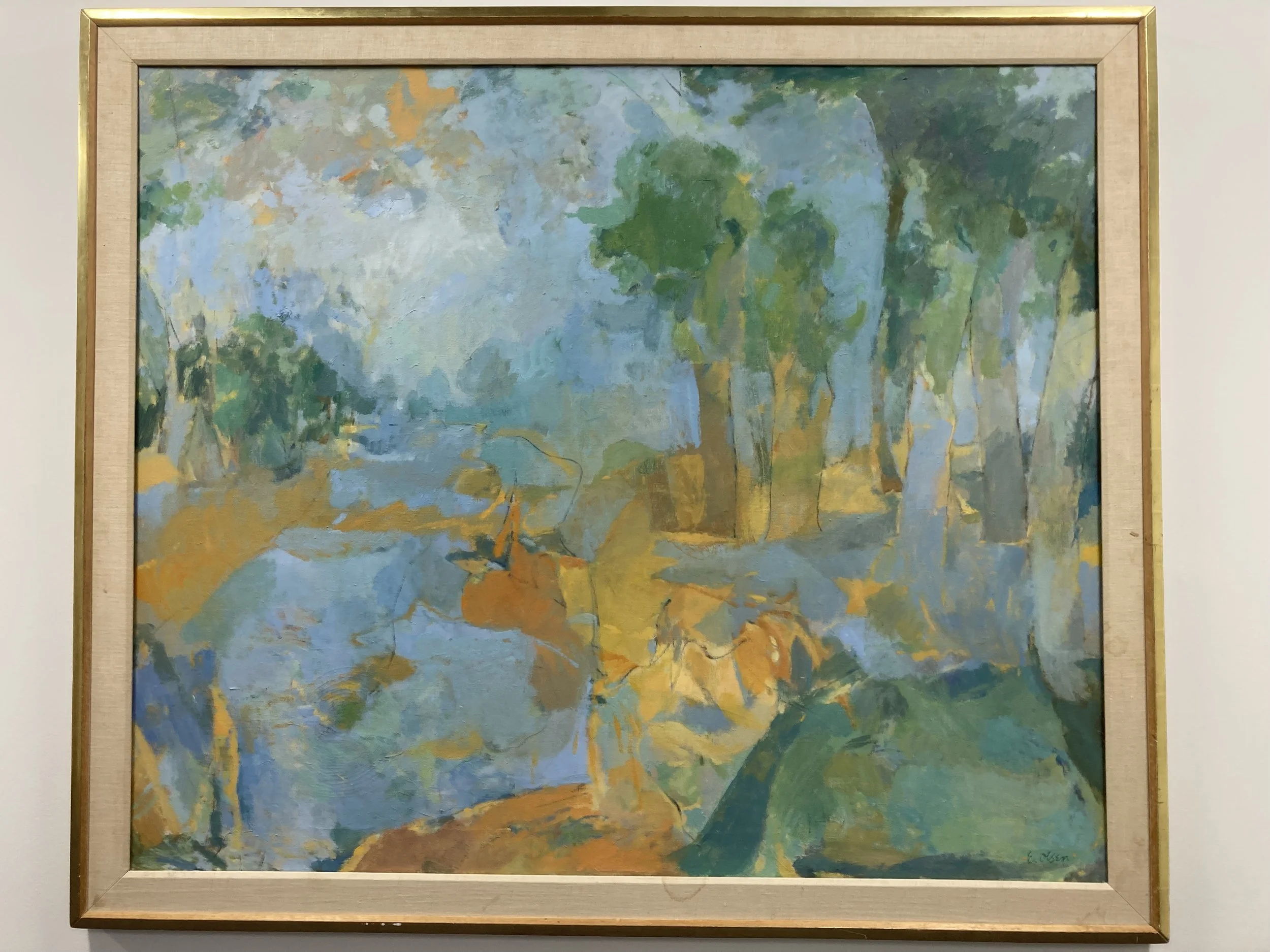Journey to River’s Edge
Earle Olsen, “River’s Edge” (1957). Brandeis Library, Brandeis University.
My artist father had a wonderful eye—great taste and an effortless sense of color and composition. Was it learned or instinctive, from his experiences or his body? I don’t know. But he had a literal eye, too. Two of them, bluish-gray. That’s what I miss since he died ten years ago: his eyes and his face. In other words, his presence.
Instead, I have his paintings. Or some of them. I’ve spent the past couple of years writing a family memoir and looking for more, whether known-and-lost like the paintings he exhibited in New York City in the 1950s or unknown but stumbled upon during my research. In September 2021 I tried to make an appointment to see the one at Brandeis University’s Rose Museum of Art, but the curators told me I didn’t need one: it was on display at the library. So I took a ferry from Cape Cod to Boston to search for it. It was Rosh Hashanah and the campus was nearly empty. I found the right building and walked the perimeter of each floor, though the deserted stacks, ascending and descending concrete stairwells, until I rounded a corner and there it was! “River’s Edge.” In full color and three dimensions. Blocky shapes of trees dominate the right side with earth tones; on the left a blue swathe suggests water.
My father painted “Rivers Edge” in 1957 and exhibited it at one of his early shows in New York City. It was bought by the collector Milton Lowenthal and ended up as part of the art they donated to the Metropolitan Museum of Art, then passed along to the Rose Museum. Brandeis was a new university in the 1950s and opened their museum in 1961. 2021 marked the tenth anniversary of my father’s death and perhaps this pilgrimage was something of a yahrzeit, a ritual motion of remembrance on the Jewish holiday of renewal. My family wasn’t Jewish and we had no particular rituals of our own, unless you counted my father’s delight in making spaghetti carbonara for dinner and crepes for breakfast. He was a bon vivant who took pleasure in ballet and antiques, Mozart and Hitchcock movies. Recovering from a brain tumor, he kept asking his hospital nurses for a glass of red wine. “They say they like my smile, so I smile!” he’d tell me and my sisters later.
He told us little about his early art career though and I had never seen most of his paintings from the 1950s. Where did he paint this? Perhaps in the Upper East Side apartment he shared with a fellow alum from the School of the Art Institute of Chicago. Which river was it? He grew up south of the Chicago River and spent most of his life on one side or other of the Hudson and East Rivers-- in Manhattan, Brooklyn, and then upstate in a big old Victorian house where you could hear the trains whistle on the other shore. I stood before the painting and thought of my father’s square-tipped fingers leaving these traces here and now.
I grew up at a river’s edge, on Riverside Drive, in an apartment my father found in a pre-war building, then moved out of almost immediately. He and my mother sat us down in their bedroom high above the water and told us they didn’t love each other any more. “River’s Edge” is a glimpse of a prelapsarian Eden--before his marriage, before their divorce, before me. Pre-history is everywhere in Boston, and tourism is another kind of search for the presence of the past. For me, though, the trip evoked literary associations. I used to teach James Baldwin’s essay “Notes of a Native Son,” about his own father’s death, and marveled at this masterful last line: “Now that my father was irrecoverable, I wished that he had been beside me so that I could have searched his face for the answers which only the future would give me now.” With those conditional verbs, Baldwin perfectly expresses the balancing act of facing backwards and forwards at the same time, of being both present and absent.
The missing face, the dead hand. My return ferry crossing, at dusk, channeled another literary evocation of loss, beyond the bourne. As the sun set behind me, I thought of the last lines of Alfred Tennyson’s “Crossing the Bar” (1889):
For tho' from out our bourne of Time and Place
The flood may bear me far,
I hope to see my Pilot face to face
When I have crost the bar.
Those capital letters suggest that Tennyson is thinking of a less earthly Father than mine or Baldwin’s, but he too insists on the importance of seeing in person, “face to face.” In these examples, art is about emotional absence, but also a concrete response to its painful abstraction. My father’s energy is dispersed now, and most visible in his surviving art works, wherever they are. When he died, my sisters and I followed his wishes and sprinkled his ashes over the Hudson River.
